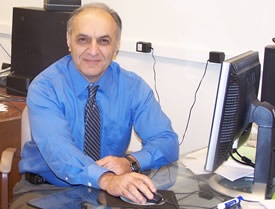Dr. A.R. Fazely

Ali R. Fazely
|
Title:
|
Emeritus Professor |
|
Office:
|
Department of Physics, Rm. 237, William James Hall, Southern University, Baton Rouge, LA 70813 |
|
Phone:
|
225-267-7254 |
|
Email:
|
fazely@icecube.wisc.edu |
| CV: | Detailed Curriculum Vita & CV |
Education
- Ph.D., Kent State University, Kent, OH, USA, 1982, Intermediate Energy Nuclear Physics
- M.A., Physics, Kent State University, Kent, OH, USA, 1980
- M.S., Mechanical Engineering, Oklahoma State University, Stillwater, OK, USA, 1977
- B.S., Mechanical Engineering, Oklahoma State University, Stillwater, OK, USA, 1975
Work Experience
- Southern University, Department of Physics 8/1998-2013: Professor, Doctoral Research Faculty, Graduate Coordinator
- Southern University, Department of Physics 8/1996-7/1998: Associate Professor, Doctoral Research Faculty, Graduate Coordinator 8/1996-7/1997: Associate Professor, tenured
- Southern University, Department of Physics 8/1992-7/1996: Associate Professor, Associate Professor, tenure-track
- Southern University, Department of Physics 8/1991-7/1992: Assistant Professor
- Louisiana State University, Department of Physics 1/1991-8/1991: Assistant Professor-Research
- Louisiana State University, Department of Physics 9/1985-12/1990: Senior Research Associate
- Louisiana State University, Department of Physics, Visiting Scientist, Los Alamos National Laboratory 2/1983-8/1985: Research Associate
- Kent State University, Department of Physics 9/1982-3/1983: Research Associate
- Langston University, Department of Physical Science 9/1977-3/1978: Physics Instructor
Research Accomplishments
- For the latest Research (CV)
- Over 200 refereed publications, including two (2) Liquid Scintillator Neutrino Detector (LSND) renowned (over 500 citations) papers. CV
- More than 200 presentations and proceedings, more than 19 invited talks.
- Had leading and pivotal role as the Deputy Spokesman and as the major author of the Oak Ridge Large Neutrino Detector (ORLaND) proposal
Administrative Experience/Grant & Contract Activities
- Established the Southern University Radiation Safety Office,
- Chairman of the Department Tenure and Promotion Committee,
- Chair of the Graduate Admission and Assistantship Committee,
- Details are available in my CV CV
Awards, Honors, Scientific Leadership & Offices Held
- Member of Sigma Xi
- Member of the American Physical Society
- Graduate Student Achievement Award in Research, Academic Year 1981-82
- Co-spokesman of Experiment 999 at the Los Alamos Meson Physics Facility (LAMPF)
- Co-spokesman of Experiment 1161 at LAMPF
- Chairman of Neutrino Facilities at the Los Alamos Meson Physics Facility (LAMPF) (1992-1994)
- Member of LAMPF Technical Advisory Panel (1992-1994)
- Deputy Spokesman for the Oak Ridge Laboratory for Neutrino Detectors (ORLaND), (1999-2001)
- University Outstanding Research/Investigator, Academic Year 04-05
BELOW ARE SELECTED GEANT SIMULATIONS FOR THE ICECUBE DETECTOR

Ali R. Fazely, Samvel Ter-Antonyan, Xianwu Xu
Southern University, Baton Rouge
fazely@icecube.wisc.edu
Description
|
Current Results for the Final IceCube Geometry (78 + 8). A SN temprature of T = 6.5 MeV is assumed. A total of 1,000,000 e+'s were simulated. These results use the latest DOM acceptance datafiles from Chiba. A 15% threshold for PE detection has been applied.
|



















